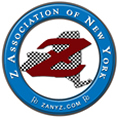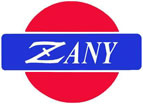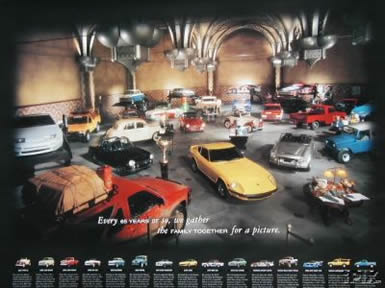 |
Z Association Of New York A Datsun / Nissan Car Club
|
 |

The Z car History
Yutaka Katayama introduced the 240z in October 1969 to the U.S. Powered with a 2.4 liter in line 6 cylinder with 2 side draft S.U. Carbs, which produced 150 Horsepower. The car only came with a manual 4-speed transmission, 4 wheel independent suspension, and front disc brakes & rear drums.
1971
The crankshaft was redesigned due to vibrations. The transmission and rear differential were also improved. A new option came available: 3-speed automatic transmission produced by Jatco. The rear hatch and rear quarter panels were given a new style.
1972
The combustion chamber shape altered, lowing the compression ratio from 9.0 to 8.8:1, which in turn, lowers the emissions and power band. A rear cross member and differential mounting were extended back 35mm to reduce the angle of the driveshaft. The driveshaft became now a 1 piece unit with only a single universal joint which reduced drive train roughness. Automatic seat belts were installed with a retractor. Rear window defroster lines were changed to be horizontal instead of vertical. Stock rim sizes were also changed to 5" from 4.5".
1973
Flat Hitachi SU carbs where installed, different manifolds and cylinders were also changed to lower the emissions. Distributor changed to transistorized brakeless ignition system. Intermittent windshield wipers were added as standard equipment. Tinted Glass. 3-point adjustable seat belts installed, and reclining seats. collapsible steering column with fire retardant interior was also introduced to the 240z.
1974
The 260z was introduced to the market. The 260z offered an increase stoke of 79mm, engine displacement was increased to the 2.6 liters, increasing the horsepower from 129 to 139. An optional 2+2 body style, with quarter windows which opened, was also introduced which lengthen the 260z by 12.2 inches and adds 200 pounds. Only available with a 4-speed transmission. Seatbelt interlocking system was introduced to some models before being dropped by production. Rear sway bar was added to all models, along with simulated wood grain steering wheels which was replaced with vinyl padded version. Bumpers received only minor updates.
1975
The 260z was introduction this year till mid year. The front and rear bumpers of the 260z was enlarged to meet Federal Regulations to have the 5mph regulation, which added approx. 130lbs to the weight of the car. Front turn signals were moved and were mounted above the bumper. Midway thru the year to 280z was introduced to the market. It was designed with withstand the tougher emission codes which includes: 3mm bore increase raised engine displacement to the 2.8 liter, producing 149 horsepower, Bosch's L-Jetronic fuel injection replaced the SU carbs on all models, transmission and differential changed gear ratios, and all California models required a catalytic converter in the exhaust system. The 280z was only sold in the U.S.
1976
Voltage regulator replaced the ammeter in the center console.
1977
Engine horsepower raised to 170HP. 5-speed manual overdrive made available. Bumper enlarged once again.
1978
Limited Edition Black Pearl was introduced on coupe models which featured black metallic finish with red and silver
1979
Second generation Z Car, the 280zx was introduced to the market. Engine, transmission and differential were original to the 280Z were carried forward to the 280ZX model. Horsepower was down to 135, 5 speed manual became a standard option, front tension rods replaced with compression rods, semi trailing arms were added to the rear, 4 wheel disc brakes (Front brake vented), A/C and power steering were standard on the 2+2 edition, GL (Grand Luxury) package was offered which includes: power steering, cruise control, headlight washers, and power windows. 280ZXR special edition was offered in limited numbers to homologate the large rear wing for racing.
1980
Due to emission regulation horsepower was reduced to 132. T- s initially became available on GL coupe models. Leather upholstery was optional. 3,000 10 year anniversary editions models were offered featuring: 2-tone paint, gold tone alloy wheels, headlamp washers, and automatic climate control.
1981
The first turbocharged Z was introduced, producing 180 HP with a 3-speed automatic transmission in coupe models only. Turbo models changed the suspension, came with larger wheels and tires, boost gauge replace the ammeter, and an oil temp gauge was combined with the oil pressure gauge. Engine and 3-way catalytic converter raise the horsepower to 145HP in the non-turbo editions.
1982
The popular turbocharged motor became available in the 2+2 Model 280ZX. New type of hoods introduce which received NACA scoops. Power rack and pinion steering became a standard option, which previously was only offered in the Turbo Edition. Bumpers was painted to match body with integrated overriders became standard option. A new interior feature introduced: Upgraded upholstery, leather seating with suede accents, voice warning system, and a digital AM/FM cassette radio.
1983
Suspension package which was offered only on turbo model was now installed on all models. A leather and digital option offered leather trim, digital dash, automatic climate controls, electric mirror defogging system, automatic rear defogger and bronze window tinting.
1984
3rd generation Z Car introduced...the 300zx. Powered with a V-6 motor producing 160 HP, and turbo was an option, which produced 200HP. Turbo model only offered on coupe editions, and were electronically controlled. 5-speed and either 3 or 4 speed automatic transmissions were available. Turbo model had a small scoop located on the driver side of the hood, and had 5 bolt pattern wheels, while the non-turbo model still only offered a 4 bolt wheel patterns. Digital dash available, while base models retained the analog gauges. GS was the only model available in the U.S. 5,000 50th year Anniversary Editions which features a turbocharged engine, fender flares, ground effects, with silver and black 2-tone paint. During 1984, it was then the Datsun name was dropped, and replaced by "Nissan."
1985
T- s became a standard option. 2-tone paint available in the Turbo models, which also featured pin-striping and body colored front and rear bumpers. Leather trim option was separated from the Electronic Equipment Package.
1986
The Turbo models lost the hood scoop. T- s became optional. Body colored side molding introduced. Integrated fender flares were added, which added a total of 2 inches to each side. The rocker panel extensions and chin spoiler became a standard option. A 3rd brake light was added, which was a high mounted light.
1987
Aerodynamics played a big part this year. The body of 300zx changed significantly. Minor engine, steering and suspension changes were made too. Driving lights were moved under the front bumper.
1988
The Turbo and Non-Turbo motors were increased by 5 HP. LE edition (Limited Edition) model featured European
Only minor trim changes were made and two new exterior paint colors were available.
1990
The 4th generation Z Car was introduced. The new 3.0 liter DOHC V-6 engine was installed: 222HP non-turbo, and 300 HP for twin-turbo model Only 280HP on automatic transmission models through the use of different fuel maps and camshafts). Engines were designed with variable valve timing and distributor less ignition system. 5-speed transmissions standard option, with the 4-speed automatic transmission as a option. Multi-link 4 wheel independent suspension was electronically adjustable on turbo models. Turbo models featured a Super HICAS hydraulically controlled rear steering. ABS and T- s standard.
1991
Drive side airbag was an option, and a hard version was available in coupe models only, with normally non-turbo engines and 5-speed transmission. Bose audio system (CD player optional), heated outside mirrors and automatic climate control became a standard option.
1992
Driver's side air bag was installed as a standard item and all T- models came with power adjustable driver's seat.
1993
The first convertible Z came to the market, which offered on non-turbo engines and added approx. 210 pounds to the car.
1994
Passenger side airbag was added. Door mounted passive restraint system replaced by 3 point manual seat belts. A/C system was revised. Keyless remote entry system became a standard option. Leather upholstery was standard on turbo models with automatic transmissions. Rear spoiler on turbo was raised from rear deck lid.